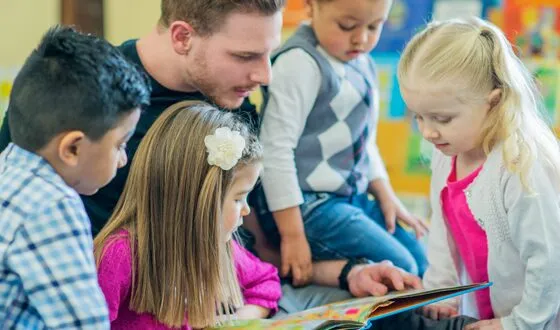5 Reasons Nonfiction Books Are Important for Young Learners


When picturing an early childhood classroom, people often imagine children immersed in pretend play scenarios acting out an adventure or celebrating a pretend birthday. The theme of imagination is often mirrored in the types of books that are offered to young children, with picture books and fictional stories typically filling up children’s bookshelves. However, research has shown that young children often prefer nonfiction over fictional books.1 This may be because children are still learning about the world around them and facts and stories about real-life topics are new and exciting!
Sharing nonfiction books helps children connect with the world around them and allows you to support children’s development and learning in five important ways:
- Foster critical thinking and information-gathering skills.
Young children are often full of questions: “What do dolphins eat?” “Why are the leaves brown?” “Why do we sleep at night?” Your first response to a child’s question may be to simply give her the answer; however, a powerful way to support children’s critical thinking skills is to refer them to a nonfiction book and find the answer together. You might say, “Hmm, that is a great question. Let’s find a book about dolphins to see if we can learn what they eat.” Using this strategy not only helps children find answers to questions they are curious about, it teaches them valuable researching and investigating skills. - Build vocabulary and language skills.
When children are exposed to books of different genres, hear the caring adults in their lives share stories, and have the opportunity to explore books, they listen to and begin understanding new language and practice sharing their thoughts, ideas, and feelings. Nonfiction books are particularly useful for building children’s vocabulary and language skills because they often introduce new words with images that support their meaning and include features like a glossary to give children a clear definition of new words. - Make real-world connections.
Since nonfiction books share facts or real-life events, they are great tools for making real-world connections to build on children’s knowledge and personal experiences. This also means that you can use nonfiction books to further enhance children’s experiences and interests. For example, if a child went on a nature hike with her family over the weekend, she may be especially interested in books about trees and leaves, or if a child has a new pet guinea pig, he may be interested in books about taking care of pets. - Comprehend increasingly complex text.
Many picture books often follow a similar format: text supported by illustrations on the page. This simple, repetitive format helps children predict the flow of the book and creates an enjoyable read-aloud experience. The format of nonfiction books, however, often varies, sometimes including features such as a table of contents, text broken into different sections with headers, and a glossary of important words. Since nonfiction books are often more complex texts, children may engage with them in different ways. With support, they may refer to the table of contents and choose one section to read or look in the glossary to learn what a new word means. - Support study-related investigations
The Creative Curriculum offers a wide variety of study topics for children to investigate, finding answers to their questions about the topic. The Creative Curriculum also includes a series of rich, nonfiction texts for each study topic that children can use to research interesting facts, see real pictures, and learn new vocabulary as they investigate. These age-appropriate texts are meaningful resources that the children can revisit as they learn more and have new curiosities throughout a study. Our Digital Children’s Library, available through The Creative Curriculum Cloud and through the SmartTeach Family mobile app, includes these nonfiction titles and provides you with an easy way to share them with families.

The Creative Curriculum includes both fiction and nonfiction for children.
1Barnes, J. L., Bernstein, E., & Bloom, P. (2015). Fact or Fiction? Children’s Preferences for Real Versus Make-Believe Stories. Imagination, Cognition and Personality, 34(3), 243–258. https://doi.org/10.1177/0276236614568632